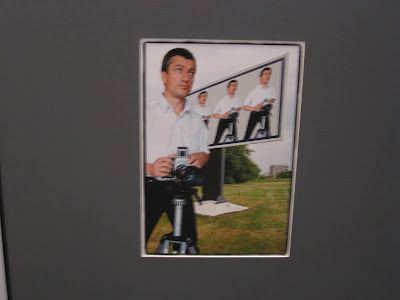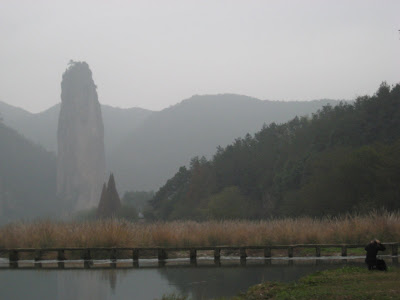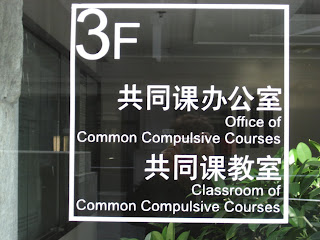
The rules for the nominators were simple. We were asked to propose up to 2 exhibitions, each containing 20-30 photos from an individual artist. The proposed exhibitions would be sent as a hi resolution digital file to be printed in China. Additionally, we were invited to bring one of the artists with us. The risks were clear from the start. We would be sending copyrighted work off to people we didn't know in a country famous for pirate copying to be printed without supervision by the artist. On the plus side, any artist exhibited would have their work seen by a huge new audience, an audience that simply would not be accessed without participating in an event like this. (There were clear promises from the Festival organizers that exhibition prints and digital files would be destroyed after the show. While this would be hard to confirm, it seemed clear that edition-quality copies were not being made. Most artists I spoke to at the end of the exhibition were confidant that their editions would not be compromised.)
My artists decided to forge ahead, and, as I found out when I arrived, dozens of others had as well. It was not all smooth sailing. A few days before we arrived, we got an email from Yan telling us that the exhibition prints were of a quality level disastrously lower than the test prints she had approved. The festival was now furiously working to reprint all of the work at an acceptable level before the opening day. Unfortunately this meant that many of the directions the artists had sent for printing would need to be set aside. This was specifically directed at the choice of scale since all of the prints would need to be printed the same size to save on paper and time. While this was not good news, I was impressed by Yan's open and forthright approach to the problem. She could have waited until we arrived to tell us of the problem. Instead, she gave a full account of the problem risking many artists pulling out or asking for their work to be withdrawn. To my knowledge, no one pulled out.
I had no expectation of finding fine-art level prints even before the printing problem surfaced, but now my standard had to be shifted to a simple question: was the artist's message still visible in these prints? The results were mixed. On the high end (which I'm happy to say included my two artists), the answer was yes. While color values were not true and scale was not ideal, the pictorial and philosophical content of the images was there to be seen. One the low end....well, perhaps the less said the better. There were some examples where it was simply impossible to see the intention of the artist. It was very unfortunate. I hope (I'm even confidant) that Lishui Festival will do better in the future.
The Western artists were all shown in a concatenation of exhibition spaces in the Baiyun Forest Park Center. It wasn't clear what the usual use is for these period buildings, but it was an idyllic place to look at art. Some illustrations-
The walk up to the entrance gate on opening day:

The Festival banner at the entrance:

The banner showing the roster of exhibitions and their corresponding exhibit halls(Carol McCusker and Stephen Bulger visible):

Detail of that banner showing my listing in a shameless act of self-promotion:

Banner map showing the layout of the exhibition halls in the park:

Picture of exhibition hall entrance where my artists were on view:

Christian Erroi and me at the entrance to our hall #1 in front of the intro to the exhibition:

Detail of that intro in 2nd act of shameless self-promotion:

Poster for Christian's exhibit:

Christian's work as it was displayed:

Christian's show, jammed at the opening:

Cornelia's wall text:

Cornelia's work as it was displayed:

Cornelia's show, jammed at the opening:

An example of the lovely bucolic setting within the park:

I have spoken about both Cornelia Hediger and Christian Erroi extensively in earlier posts, so, rather than write more here, I will simply invite you to visit their websites which are highlighted and hyperlinked.
Other than my own artists, I had a couple of other favorites. At the top of the list was Dutch artist, Petra Stavast. Ms Stavast's work was unfortunately one of the casualties of the printing debacle. Her salvation was in her nominating curator, Marga Zijvanrotteveel. Ms Zijvanrotteveel's essay on "Libero", the project of Ms Stavast, was so compelling, concise, and thoughtful I knew there was more to the work than what I saw on the wall (look for more from this smart, young, independent curator). Fortunately for me, both Mss Zijvanrotteveel and Stavast were in Lishui so I had the chance to discuss the work and learn more.
"Libero" is a story that starts in a derelict house in Calabria and ends in suburban New Jersey. Ms Stavast found photos and remnants of a rich but abandoned life in Italy and decided to follow that evidence to wherever it took her. She tracked down the descendants of the family that had lived in Calabria and reconstructed a family history in a way that is personal and universal. She made her work into a book which I have to say is one of the most compelling publications I've seen this year. I don't think I've ever seen an artist so successfully weave found , vernacular photos with her own personal work. It is unique. It strikes me as some wonderful union of Leigh Ledare, Miyako Ishiuchi, Erik Kessels, and Joachim Schmid. You can read more about it here and you can order a copy here from Roma Press. Also available at Photo-eye. Highly recommended.
Also high on my list of discoveries was Carol McCusker's nomination of Stephen Berkman for his series called "Predicting the Past". Mr. Berkman works exclusively in antiquarian processes, so digital prints of his work are, I'm sure, a shadow of the real thing. But the wit, intelligence, and perspective were clearly evident even in dodgy digital format. Humor is a high-wire act in art as I've discussed before in work like Thorsten Brinkmann's. But when it works it can be a tour-de-force. I'm eager to see actual prints of Mr. Berkman's tintypes and wet plate collodions. The dialog he creates between antique process, antique portraiture, and contemporary staged photography is well worth a look.
Some examples. The first is titled "Mute Debating Society":



and Ms McCusker's paragraph about the show:

I was also taken with Sarah Wilson's work called "Blind Prom". I had seen the work when she had a show at Michael Foley's gallery earlier this year. I was impressed with it then, and it held up well in a second viewing with less than ideal prints. The history of photography is rich with artists who have used photographing those who can't see both as an ironic device and also as a means to take the self consciousness out of portraiture. Ms Wilson's work seems to be an unsentimental but poignant addition to the canon.
Last, I want to mention Mindaugas Kavaliauskas' series, "52 weeks, 52 self portraits". Neither the artist nor his nominator, Kazimieras Linkevicius were in attendance. I was intrigued by the work and wanted to see the whole series. As I said, humor is a high-wire act. I'm not sure if this one stays on its feet, but I'm sure I want to know more. What I saw suggested a fertile visual imagination and a mordant political wit. So far my online investigations have yielded little more information, mostly in websites in Lithuanian. If anyone has more information about this artist, I'd love to hear. I can't find a website either for the artist or the curator. Here are a few examples from the exhibition:



To briefly sum up, this was a wonderful adventure for me. I'm thrilled that I went even with all the challenges and disappointments. I remain a bit confused as to why all of the Western artists and nominators were brought all the way to China, but I'm glad they did. I hope if we're invited again that there will be much, much more interaction with Chinese artists, curators, art lovers, and gallery owners. It seems a shame to have all these American and European voices in China and not use them to communicate with their Chinese counterparts. On the plus side, thousands of Chinese people saw photography they simply would not have seen any other way, and we saw Chinese art that we can take to new corners of the world. And let's not forget that it took a Chinese festival to introduce me to Western work I had never seen before. All in all, a good experience. I'd go again in a heartbeat.
Next: I head to Shanghai.



































